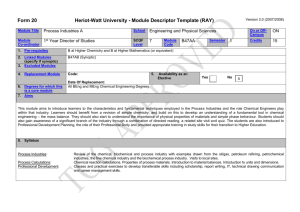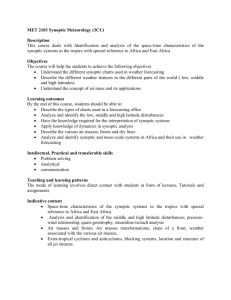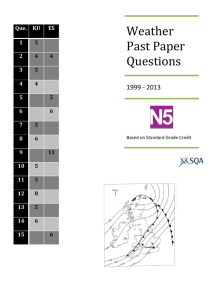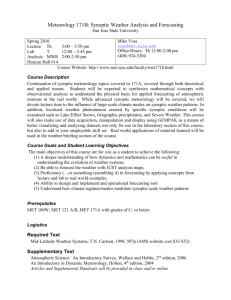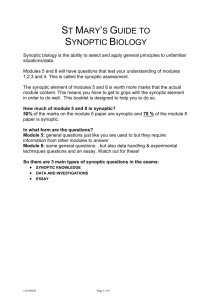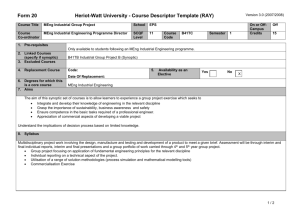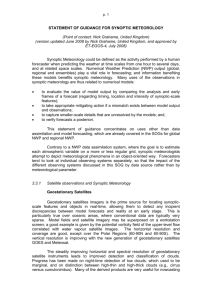Name: Date: ______ LAB: Weather Patterns
advertisement
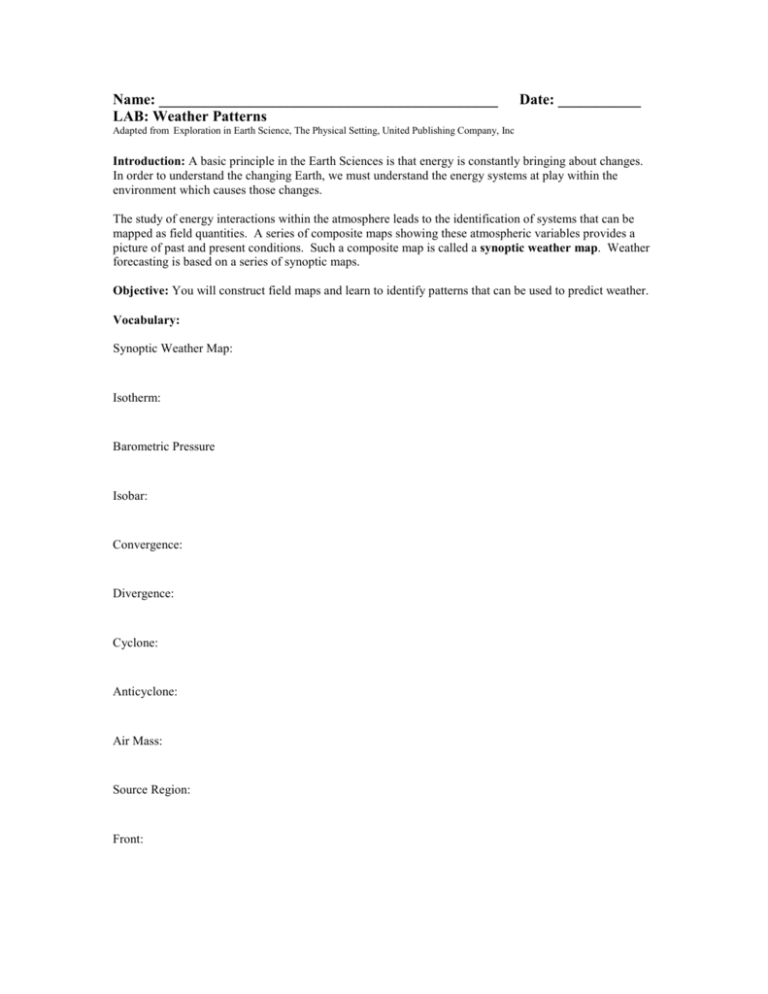
Name: _____________________________________________ LAB: Weather Patterns Date: ___________ Adapted from Exploration in Earth Science, The Physical Setting, United Publishing Company, Inc Introduction: A basic principle in the Earth Sciences is that energy is constantly bringing about changes. In order to understand the changing Earth, we must understand the energy systems at play within the environment which causes those changes. The study of energy interactions within the atmosphere leads to the identification of systems that can be mapped as field quantities. A series of composite maps showing these atmospheric variables provides a picture of past and present conditions. Such a composite map is called a synoptic weather map. Weather forecasting is based on a series of synoptic maps. Objective: You will construct field maps and learn to identify patterns that can be used to predict weather. Vocabulary: Synoptic Weather Map: Isotherm: Barometric Pressure Isobar: Convergence: Divergence: Cyclone: Anticyclone: Air Mass: Source Region: Front: Reading Comprehension: Read the article below on Synoptic weather maps and answer the questions that follow (in complete sentences) to better understand the maps you will be making in this lab. What Is a Synoptic Weather Map? by Amy Harris, Demand Media http://traveltips.usatoday.com/synoptic-weather-map-63165.html Synoptic weather maps cover large areas, such as the continental United States. If you've ever watched a national news channel, a weather network, or even opened a newspaper to the weather section, you've likely seen a synoptic weather map. Synoptic weather maps, while a crucial tool for meteorologists, specialists who forecast the weather, are commonly available to the general public. Such maps can help you know what type of weather conditions to expect in the near future, understand weather patterns as a whole and determine the weather in a far-off destination to which you may be traveling. Definition The word "synoptic" takes its roots from two Greek words -- "syn," meaning "the same" or "together," and "optic," meaning "visible." Thus, synoptic literally means "together visible." "Synoptic" can be thought of as analogous to "comprehensive" -- that is, combining multiple sub-elements to provide a general overview, or "big picture." In terms of a weather map, this correlates to displaying simultaneous atmospheric conditions over a broad area, such as a state, region, country or continent. Due to the overarching nature of a synoptic weather map, its focus is primarily large-scale systems such as cyclones and fronts, rather than localized occurrences such as a severe thunderstorm. Generating a Synoptic Weather Map Information from a great many geographic locations is necessary to construct a synoptic weather map. At a specified time -- often every three hours or every six hours -- meteorologists in a vast array of cities and towns take weather readings. Such readings include temperature, cloud cover, barometric pressure, dew point, precipitation amounts and wind speed and direction. Precise measurements, such as those of temperature, barometric pressure, precipitation and wind speed, must be made using standardized techniques and instruments, in order to ensure uniformity across all locales. After the data from each location has been collected, the National Weather Service or other meteorological organization compiles the synoptic weather map. Features All synoptic weather maps consist of a base political map of the area being studied, but not all synoptic maps display the exact same information. Some maps may show only temperatures, while others display a combination of high and low pressure systems and cold and warm fronts. Oftentimes, synoptic weather maps contain an overlay of radar imagery -- usually portrayed in shades of green -- reflecting precipitation. You can easily become familiar with the symbols commonly used synoptic weather maps; for instance, cold fronts are denoted by a blue line with attached blue triangles, while red lines with adjacent red halfcircles represent warm fronts. Time Synoptic weather maps typically amalgamate the conditions observed across multiple time zones, rendering it necessary to use a universal clock; hence, weather readings around the world are notated in UTC, or Universal Time Coordinate. This 24-hour clock is essentially what Americans refer to as "military" time, but it operates with respect to the current time in Great Britain, known as GMT, or Greenwich Mean Time. To convert local time to UTC, meteorologists first convert the time to a 24-hour clock, then add or subtract the number of hours, or time zones, between the specified location and the time zone in the United Kingdom. 1. What is a synoptic weather map? 2. What are some weather variables we can plot on our synoptic weather maps in this lab? (list at least 3). 3. Why is it important for meteorologists to use standardized techniques and instruments? 4. If you had a synoptic weather map of today’s weather, where on the map would you look to infer what tomorrow’s weather will be for Boonville? The series of synoptic weather maps below may help you. Map A: TEMPERATURE PATTERNS 1. 2. 3. Use a pencil to lightly draw isotherms at 10ºF intervals. Check carefully to be sure the isotherms are correct, and then darken them. Answer the discussion questions that follow based on the map you drew. 1. What is the general appearance of isotherms on this map? 2. How does the temperature change from north to south on this map? 3. Near which cities is the temperature gradient greatest? 4. Calculate the temperature gradient between Galveston and Kansas City. SHOW ALL WORK AND LABEL PROPERLY. 5. Calculate the temperature gradient between Cincinnati and Chicago. SHOW ALL WORK AND LABEL PROPERLY. Map B: BAROMETRIC PRESSURE PATTERNS 1. Use a pencil to lightly draw isobars between points of equal atmospheric pressure. Use a 4 millibar interval. Start counting at 1000.0 mb (000). 2. Check carefully to be sure the isobars are correct, and then darken. 3. Label the centers of the high and low pressure areas using a capital H and L respectively. 1. What is the general appearance of the isobars on this map? 2. The low pressure center is near which city? 3. The high pressure center is near which city? 4. What is the highest air pressure on the map? 5. What is the highest value for an isobar on this map? 6. As you travel from Salt Lake City to Los Angeles, what change in atmospheric pressure would you observe? 7. Calculate the pressure gradient between Little Rock and Galveston. SHOW ALL WORK AND LABEL PROPERLY. Map C: SURFACE WIND PATTERNS 1. At each station model, extend the shaft of the wind arrow through the station model and draw the head of the arrow to show the direction the wind is blowing 2. Draw larger arrows to show the general pattern of airflow around the high and low pressure centers. 1. Describe where there is a big change in wind direction in the eastern part of the country. 2. Describe the general surface wind pattern around a low pressure area. 3. Are surface winds around a low pressure area convergent or divergent? 4. Describe the general surface wind pattern around a high pressure area. 5. Are surface winds around a high pressure area convergent or divergent? Map D: PRECIPITATION PATTERNS The standard symbol for rain on a map is a “dot” (•) below the temperature on a station model. In this exercise, an “R” is placed inside the circle to make it less confusing. 1. Draw a line around the area on this map where there is precipitation. 2. Lightly shade in the area where precipitation occurs. 3. Label the location of the continental polar and the maritime tropical air masses using the appropriate symbols for each. 1. Where is the precipitation occurring relative to the continental polar and maritime tropical air masses on this map? 2. Describe, step by step, how clouds form over the low pressure center. 3. Compared to areas of low pressure, why do areas of high pressure have fewer clouds? Map E: SYNOPTIC WEATHER MAP 1. Refer to the previous maps and draw isotherms, isobars, wind patterns and the area of precipitation on this map. Draw them in lightly. 2. Using that information, draw in the cold and the warm fronts with the proper symbols. 1. With respect to the cold front, where does precipitation occur? 2. With respect to the warm front, where does precipitation occur? 3. What two characteristic are used to describe an air mass? 4. Compare the characteristics of an air mass to its source region. 5. Compare the following conditions on either side of the cold front: a. Temperature: b. Air Pressure: c. Wind direction: Conclusion Questions: 1. 2. Describe the general weather conditions associated with a high pressure area in terms of: a. Temperature: b. Wind patterns: c. Cloud development: d. Precipitation: Describe the general weather conditions associated with a low pressure area in terms of: a. Temperature: b. Wind patterns: c. Cloud development: d. Precipitation:
